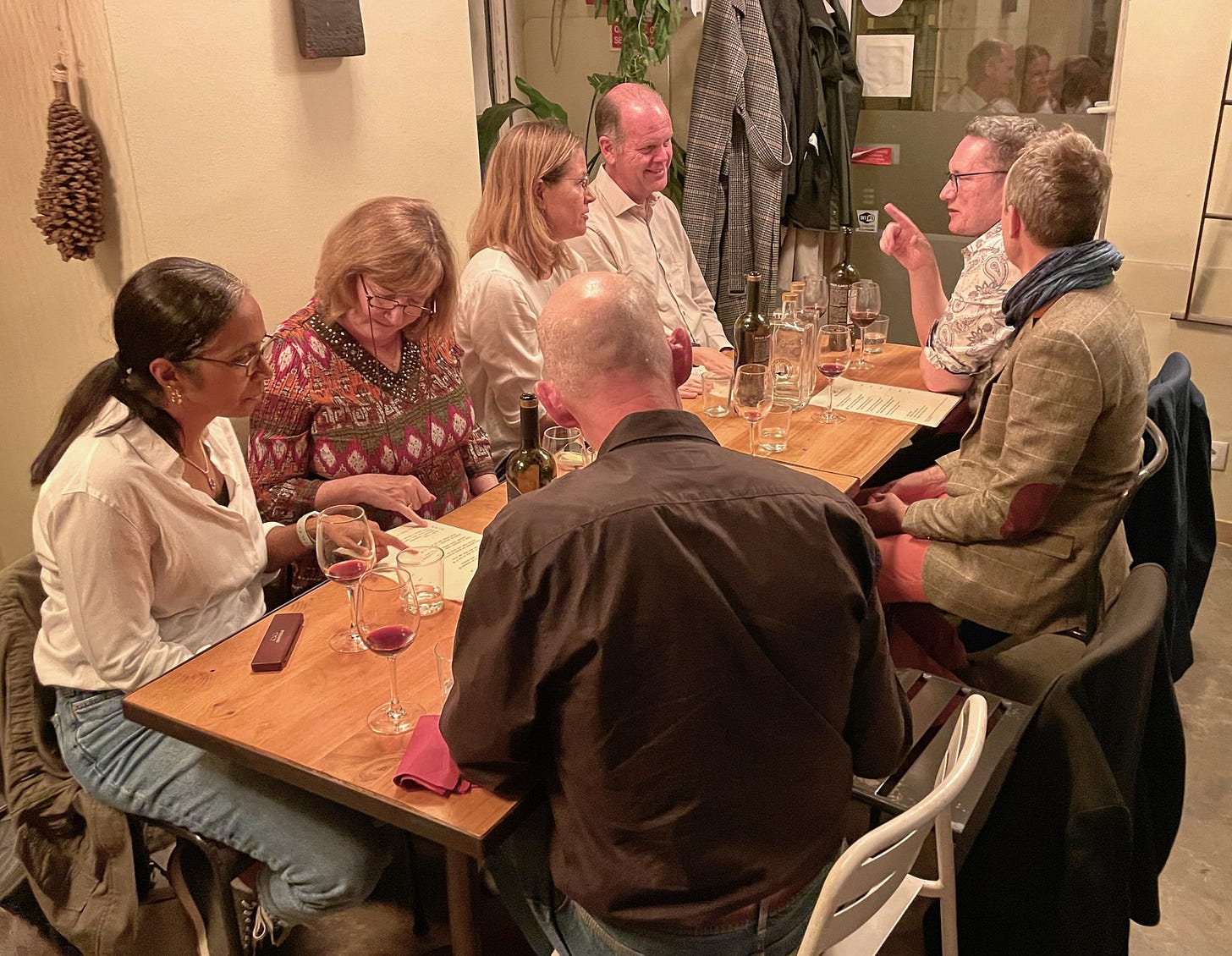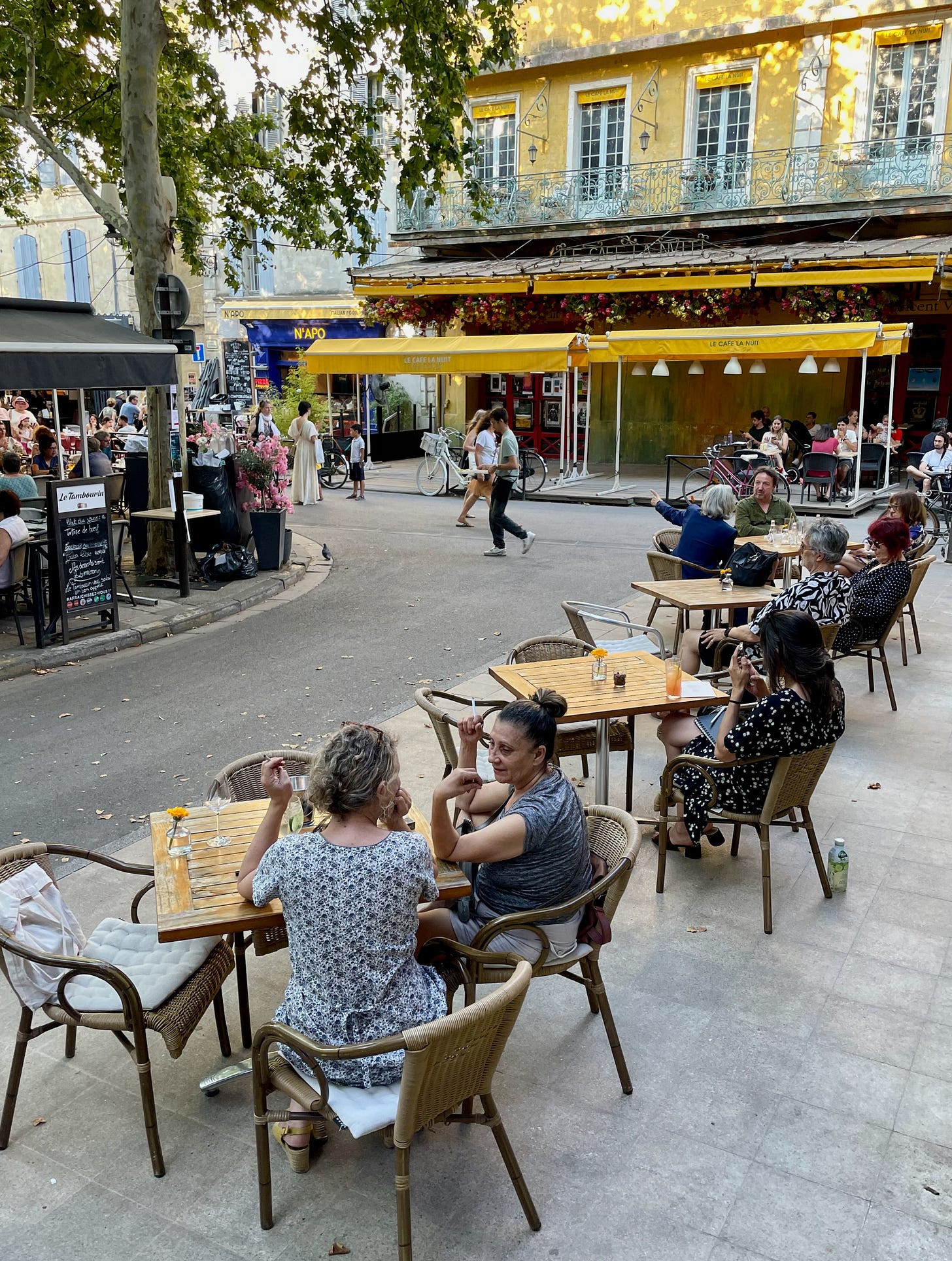Prologue
In recent months, I have been quietly acquiring paying subscribers—also known as My Favorite People Ever, because they’re helping me earn money by writing. Thus far, these folks have been offering me their hard-earned money without receiving very much in the way of special content. I feel that this needs to be remedied, and this essay marks the beginning of one attempt to do so. (Don’t worry, there’s no paywall coming up.)
I think a lot about clear and effective communication—in fact, it is something of an obsession of mine. For someone with a PhD in linguistics who has studied and taught related topics for decades, this is possibly not surprising. Even now that I’m no longer teaching at university, I still give lectures and workshops on effective communication. So it seems fairly natural for that interest to find a place in this substack, in which communication is one of the recurring motifs.
My plan, then, is to produce a series of essays on the art of conversation. This essay that you are holding in your cyber-hands is the first of the series; like all of the Friday essays at Living Elsewhere, it is free and available to everyone. The rest of the series will be accessible to paying subscribers only; these pieces will be published in addition to the usual Friday essays, which will always remain freely available.
Here are the provisional titles of the pieces I am planning to include in the series The Art of Conversation:
The Art of Good Conversation (this essay)
Conversation and Fear
A New Model of Conversation
On Being a Good Listener
How to Ask Good Questions
The Exquisite Art of Small Talk
If you are already a paying subscriber, you will receive all of these automatically—you don’t have to do anything special. They should come out at the rate of one per month, on a Monday. If you are currently a free subscriber, you can easily get all of these by choosing any of the upgrade options. Again, paid subscriptions support my work on Living Elsewhere, something for which I am immensely grateful.
So, now that we know where we’re heading, let’s set off and start talking about the art of conversation.
Why talk to other people?
If the art of conversation seems to you like a frivolous topic to consider when there are so many problems in the world, I would like to point out that it will be hard for you to help solve those problems unless you safeguard your own psychological well-being. Your interactions with others are central to this effort. Psychologists Gillian Sandstrom and Erica Boothby (2020) put it this way:1
Research in the field of positive psychology makes a strong case that social relationships are the single most important predictor of people’s well-being, going so far as to argue that people, with their powerful need to belong to social groups (Aronson, 2012; Baumeister & Leary, 1995; Dunbar & Shultz, 2007), cannot maximize their well-being without having meaningful social relationships (Diener & Seligman, 2002; Lyubomirsky et al., 2005). Happier people spend more time talking to others (Mehl et al., 2010; Milek et al., 2018), and when people have more conversations with others, they report being happier (Sandstrom & Dunn, 2014b; Sun et al., 2019; Watson et al., 1992).
So engaging in conversation can be seen as an essential act of self-preservation. Moreover, conversation is one of the most critical tools at our disposal when we try to solve the problems in our own lives and in the world. Most of the work that we do—including trying to change the minds of others—is accomplished through language. So knowing how to skillfully engage another person in conversation is, perhaps, highly relevant after all.
What is conversation?
When I say “conversation”, I don’t mean to conjure up images of oak-paneled studies filled with cigar smoke and people swirling brandy in snifters—although I see that I have now done just that. For our purposes, let’s say that “conversation” means any spoken interaction between two or more people in which the participants are relatively equal, meaning that there is not a significant asymmetry in power or role. In other words, if your boss calls you into her office to dress you down for your behavior at a recent meeting, that is not the sort of “conversation” that we are talking about here.
Can a conversation take place in writing? Yes, it can, though there are a couple of caveats. For one thing, the more a textual exchange resembles a spoken interaction—meaning that it happens in close-to-real time, and with relatively short turns—the more easily it can be called a conversation. For another, it’s important to note that texting brings with it a host of highly particular conventions that make it rather different from ordinary face-to-face interaction.
Another question is whether talk with a purpose counts as conversation. If two or more people are engaged in solving a problem together (whether that be making an omelet or debating a nuclear strategy), is that really a conversation? I think that the model of conversation that I will be proposing does allow for these interactions to be called conversations. However, in order to focus our efforts a bit, I would like to concentrate on conversations with a social purpose—the sort referred to above, that helps us to build meaningful social relationships and increase our general well-being.
The Eight Truths of Conversation
Not long ago, I ran a workshop in which I proposed, with a secret wink to the Buddha, the “Eight Truths of Conversation”. They looked like this:
Connection is essential to human well-being.
Connection is achieved through reciprocity and vulnerability.
Reciprocity means matching another person in mood, energy, and sharing.
Vulnerability means showing others the real you.
Being good at conversation is a learnable skill.
The key to good conversation is taking an interest in the other person.
One shows interest by asking good questions and listening skillfully.
Skillful listening is what enables reciprocity.
These “truths” describe a cycle with interlocking elements that enable each other:
I will be talking about all of these elements over the course of this series. Let’s start here with the notion of taking an interest in another person, which is related to the important concept of liking.
The importance of liking
In my recent essay “Being a Stranger Back Home”, I mentioned a therapist I once had who said, “All people want is to be liked”. I think that this is an important observation that can be of great value in conversation. We could even say that, in one sense, conversation is the practice of using language to show someone that you like them and want to establish a bond with them.2 If this aspect is missing, then it’s really just information exchange.3
Note that I say conversation is about showing that we like someone; it is not about prompting someone else to like us. This is the great mistake made by those who are boastful. Let me tell you a secret: Trying to impress people seldom works. It simply turns them off. Pontificating or “mansplaining”—even in the event that it garners a bit of respect—will also never result in liking. You may notice a problem emerging here: Many of the behaviors that men are traditionally taught to engage in result in the opposite of liking. This is terribly unfortunate.
What is it that actually does foster liking, then? As much as many men (and women, too) will hate to hear this, it is vulnerability. The only thing that is certain to impress people in conversation is being real, not pretending, and not hiding. Of course, this is not easy to do. It doesn’t come naturally to most of us, because we were raised to self-protect. Brené Brown defines vulnerability as “uncertainty, risk, and emotional exposure”. Doesn’t that sound terrifying? And yet it’s what we look for in others.
As an aside, do not confuse liking and comfort. We tend to feel more comfortable with people who seem to resemble us, but this is not really liking—it is the absence of disquiet. To associate only with individuals who narrowly resemble us is to shy away from the more difficult task of learning to like something unfamiliar.
Here is the problem with avoiding risk and emotional exposure: People can only like us if we give them something to like. You need to put yourself out there and show some vulnerability in order for others to have any material to work with in trying to like you. But the very fact that you are willing to do so will predispose them to like you, so there is simply no superior gambit.
Another thing that is infallibly likable is the ability to laugh at oneself. We all feel sorry for people who take themselves too seriously and feel admiration for people who can make fun of themselves. I tell people that being able to laugh at yourself is a superpower—if you can do that, people will forgive almost anything.
Taking an interest in someone
Here is another observation that can be very helpful: People tend to like those who take an interest in them. Since liking tends to rise like a double helix between two people, the best way to be liked is to start liking. This means encouraging another person to open up and reveal themself to you.
The most important thing here is to be truly curious about the other person. Do not fall back on assumptions and stereotypes—prepare yourself to be surprised by what you learn. Everyone you will ever meet is an expert on something, whether it’s military history, progressive rock, Serbian cinema, Japanese manga, Italian divorce law, hair styles of the past century, or buttermilk biscuits. I once met an aesthetician who told me that the surest place to look if you want to gauge someone’s age is the skin right in front of the ear. I still remember this.
So learn what you can from the other person, and learn what you can about them. It is also very, very helpful to learn the person’s name. (I wrote once about why the Portuguese are so good at this.) When you take the trouble to learn someone’s name, and then show that you have learned it, it instantly upgrades the quality of the relationship between the two of you. We know the names of the people we care about, so learning someone’s name shows that the door to a possible friendship stands open.
In a later essay, I will talk about compliments, and how much heavy lifting they can do in building relationships of all kinds. Some people say they don’t give or trust compliments—but if someone wanted to recommend your substack or your business, you wouldn’t mind, would you? When people say kind things about us, it makes us feel wonderful, and that feeling is associated with them in our memory. As they say, people don’t remember what you said, they remember how you made them feel.
Push vs. pull
Something that complicates the process of becoming good at conversation is the fact that, very broadly speaking, there are two models of how it can work. I will call these the “push” model and the “pull” model. These terms come from information technology and refer to how and when information is transferred.
For example, let’s take Substack: If you want to know whether there are any new posts from the authors you subscribe to, you can take out your phone, open the Substack app (you have installed it, right?), and look at it. This is a pull model, in which you ask for information when you want it. Or, you can enable “push notifications” in the Substack app, in which case every single time a new post is published, your phone will make a little plinging sound. This is a push model, in which you are given information without asking for it.
As an aside, the fact that the push model has become dominant in technology is, I believe, partly responsible for the rapid degradation of people’s attention spans today. It also helps to explain why fewer people read books—books use a pull model, and many people are now used to just receiving text passively.
To bring this back to conversation, I have seen that some people tend to use a push model in conversation, when what we really want is a pull model. A push model is based on telling, while a pull model is based on asking. I remember a roommate I had in college, with whom I would have conversations somewhat like this:
A: I’m so worried about this exam tomorrow.
B: I don’t think Jeanine really likes me.
A: I still have sixty pages to get through. I’ll never make it.
B: She probably doesn’t even know I exist.
A: Maybe I need to pull an all-nighter. But then I’ll be tired.
B: Maybe I should talk to Marge. Marge is Jeanine’s friend—I could ask her what she thinks of me.
And so on and so forth. This is clearly a completely dysfunctional “push” style of conversation. More usual is a case in which people take turns telling each other things, supplying some minimal responses, and repeatedly grabbing the focus. Here is an example:
A: Hi there.
B: Hi! How are you?
A: Well, actually, I think I sprained my ankle.
B: Oh, I sprained my ankle once. It was terrible.
A: Yeah, it really hurts. I think maybe I’ll go to the doctor.
B: I went to the doctor last week. Had my sutures out. It went really well.
A: That’s nice. I need to find someone to drive me though.
B: Well, I can’t drive you, because my car’s in the shop. Can you believe that Dan hit the trash cans again?
A: Did he now.
This dialogue is invented and is therefore not fully realistic. But the point I am trying to illustrate is that these people are engaged in telling each other about themselves rather than in asking questions about each other. And the magic lies in questions.
Questions are everything
The secret to being an excellent conversationalist isn’t having a vast storehouse of tales about outlandish adventures in Algeria and Kazakhstan. No, the secret is being able to ask good questions, listen carefully to the answers, and meet the other person where they are, intellectually and emotionally. I will go into detail about all three of these things in upcoming posts in this series. Here I will just say three very important things about questions.
First, good questions are usually born of real curiosity. Rather than sticking “safely” to formulaic questions such as “How are things?”, which seldom lead to interesting discussion, try to think about what you don’t know about this person but would like to find out. We have already talked about the importance of taking an interest in the other person. The way to put this into practice is to ask questions.
If someone told you that they worked for the post office, you could say, “Oh really? What’s that like?” or “What kind of schedule do you have?” or “What are the people you work with like?” or “What do you like about your job?” Hopefully, this would lead the other person to divulge some interesting information, which could lead to more questions.
Second, note that all of the questions in the previous paragraph were open-ended questions. It is far better to ask a question like this, which allows the other person to decide how to answer it, than to ask a yes/no question, which allows for a very limited range of responses.
Third, it is not enough to ask just one question. The real secret to developing a good conversation is to ask follow-up questions. This is less common than you might think. It requires us to take a genuine interest in the other person, which means really thinking about the things they are saying. Here is an example:
A: So you work at the post office? What’s that like?
B: It’s all right. I mean, the pay’s not great, but it’s a stable job, and the conditions are pretty good.
A: What are the people you work with like?
B: Well, there’s all kinds. Some of them are lots of fun, but some are kind of always stressed out and grouchy.
A: Hmm. What do you think makes them stressed out?
B: Well, we have a lot to do, and there’s always time pressure. Plus, the government has announced cuts, and people are worried about losing their jobs.
A: Are you worried about losing yours?
B: Actually, a bit, yeah. I haven’t been there as long as some people, and so I might be let go before them. And I have a son who needs expensive medical treatments, so if I lost my job, it would be a disaster.
A: That sounds hard. Tell me about your son.
etc.
There is nothing extraordinary going on in this example (which is also fictional). What is happening is that A is really listening to what B is saying, and is finding ways to ask open-ended questions that gradually lead to greater intimacy, and a more interesting and personal conversation.
What’s next
There is a lot to say about the art of conversation. The next essay in this series will deal with the main reason why people find it so difficult to talk openly and honestly with others: fear. This takes many different forms, and we will go through several of them, as well as looking at what one can do to allay those fears. The subsequent essays will present a model of conversation to help illuminate what happens when we talk with people; will go into the difficult but incredibly important skill of listening; will explore how questions operate in conversation, including the kinds of questions that make for the best conversations; and finally, will talk about the art of “small talk”—an unfortunate and unfair name for an activity that is sometimes the genesis of the most important things that happen in our lives. I hope that this all sounds interesting to you, and that you will join me in the conversation.
Talk to you soon!
Gillian M. Sandstrom & Erica J. Boothby (2020): “Why do people avoid talking to strangers? A mini meta-analysis of predicted fears and actual experiences talking to a stranger”, Self and Identity, DOI: 10.1080/15298868.2020.1816568
In linguistics, this is generally referred to as phatic communication, or communication with a purely social function.
There is also a lot to be said for talking to people who we don’t yet know. I wrote about this recently in the essay “Talking to Strangers Can Change Everything”.













I’m about to get up to go look at the skin in front of my ear, but first wanted to say that it sounds like you’d make a great therapist!
Love the essay and the topic. One of my favorite questions to ask couples (whom I don't know well) is "How did you two meet?" Couples love talking about how they've met. Relaxes everyone, I've found, because it's usually a topic they cherish. I also love asking elderly people questions about their life. It always kinda makes me teary, thinking about elderly people wanting to relive their memories but not having much of an opportunity to do so. Again, I really like your pictures. Two in particular stood out. The first one is so lovely. I wonder where that is. And two of the people seated at the table having a conversation are my friends Helen and John. Small world!